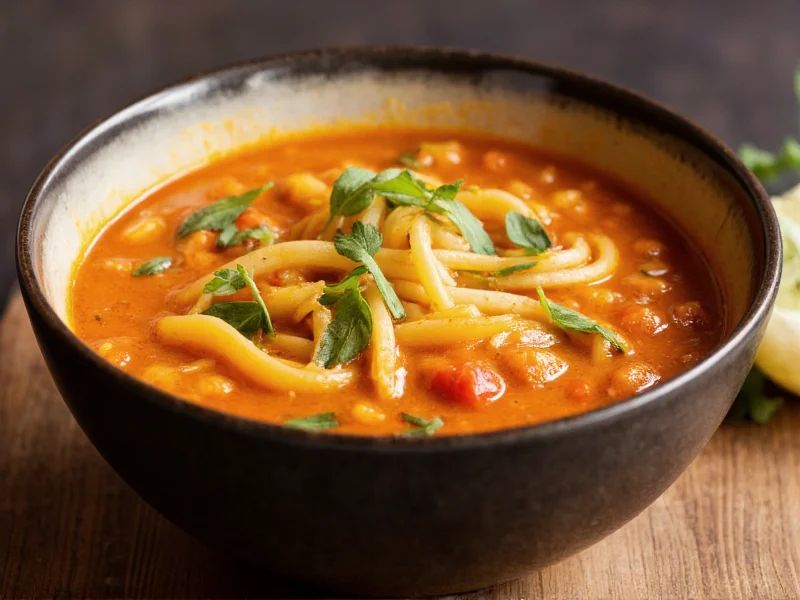For centuries, minestrone soup has nourished Italian families with its flexible, seasonal approach to cooking. This iconic dish represents cucina povera—Italian peasant cooking that transforms humble ingredients into satisfying meals. Unlike rigid recipes, authentic minestrone adapts to available produce, making it both practical and deeply connected to Italy's agricultural rhythms.
The Historical Roots of Minestrone
Minestrone's story begins in ancient Rome, where minestra (meaning "something served") referred to any thick soup or stew. Roman soldiers carried portable versions made with grains, vegetables, and legumes. The modern minestrone evolved during the Middle Ages when tomatoes arrived from the Americas, transforming the broth's character. Each Italian region developed distinctive variations—Liguria's version features pesto, while Sicilian minestrone often includes eggplant.
Essential Ingredients for Authentic Minestrone
True minestrone balances five key components:
| Component | Traditional Examples | Purpose |
|---|---|---|
| Base Vegetables | Onion, carrot, celery (soffritto) | Flavor foundation |
| Seasonal Produce | Zucchini, green beans, cabbage, tomatoes | Nutritional variety |
| Legumes | Cannellini beans, borlotti beans | Protein and texture |
| Starch | Small pasta, rice, or potatoes | Heartiness |
| Finishing Elements | Parmesan rind, olive oil, fresh basil | Flavor enhancement |
Traditional Minestrone Recipe
This authentic minestrone soup recipe serves 6 and requires 1 hour preparation:
Ingredients
- 3 tbsp extra-virgin olive oil
- 1 onion, finely chopped
- 2 carrots, diced
- 2 celery stalks, diced
- 4 garlic cloves, minced
- 1 zucchini, cubed
- 1 cup green beans, trimmed
- 2 potatoes, peeled and diced
- 1 (28-oz) can San Marzano tomatoes
- 6 cups vegetable broth
- 1 Parmesan cheese rind
- 1 cup cannellini beans, cooked
- ½ cup small pasta (ditalini or elbow)
- Fresh basil and parsley
- Parmesan cheese for serving
Preparation Steps
- Sauté onion, carrots, and celery in olive oil until softened (8-10 minutes)
- Add garlic and cook until fragrant (1 minute)
- Incorporate zucchini, green beans, and potatoes; cook 5 minutes
- Add tomatoes, broth, and Parmesan rind; simmer 30 minutes
- Stir in beans and pasta; cook until pasta is al dente
- Remove Parmesan rind; stir in fresh herbs
- Season with sea salt and black pepper to taste
Regional Variations Across Italy
Minestrone's beauty lies in its regional diversity. Northern versions often include rice instead of pasta and feature root vegetables. Central Italian minestrone typically contains tomatoes and pasta, while southern variations might incorporate eggplant or peppers. Ligurian minestrone includes pesto for finishing, and Venetian risi e bisi (a minestrone variant) focuses on rice and peas. These authentic minestrone soup variations demonstrate Italy's culinary diversity while maintaining the dish's essential character.
Cooking Techniques for Perfect Minestrone
Mastering minestrone requires attention to key techniques. The soffritto (onion-carrot-celery base) must cook slowly to develop flavor without browning. Add vegetables in stages based on cooking times—hard vegetables first, delicate greens last. Never boil vigorously; a gentle simmer preserves vegetable integrity. For depth of flavor, include a Parmesan rind during cooking (remove before serving). When making minestrone soup from scratch, remember that the broth should taste balanced before adding pasta, as starches will dilute flavors.
Nutritional Benefits of Minestrone
Minestrone soup offers remarkable nutritional density. One serving typically contains:
- High fiber content from diverse vegetables and legumes
- Complete protein profile when beans and pasta combine
- Essential vitamins A, C, and K from seasonal produce
- Healthy fats from quality olive oil
- Low calorie count (approximately 250-300 calories per serving)
This healthy minestrone soup composition makes it suitable for various dietary needs while delivering complex carbohydrates and plant-based nutrition.
Serving and Storage Guidelines
Serve minestrone hot with a drizzle of premium olive oil and freshly grated Parmesan. It pairs beautifully with crusty bread for dipping. Properly stored in airtight containers, minestrone maintains quality for 4-5 days in the refrigerator. For longer storage, freeze portions for up to 3 months. When reheating, add a splash of water or broth as the soup thickens upon standing. The best vegetables for minestrone soup actually improve in flavor after 24 hours as ingredients meld.
Frequently Asked Questions
What's the difference between minestrone and vegetable soup?
Minestrone differs from standard vegetable soup through its specific Italian preparation methods, inclusion of beans and pasta/rice, use of soffritto base, and traditional finishing with Parmesan and olive oil. Authentic minestrone follows seasonal availability principles and often includes a Parmesan rind during cooking for depth of flavor.
Can minestrone soup be made vegan?
Yes, authentic minestrone can easily be vegan by omitting the Parmesan rind and cheese garnish. Many traditional versions were originally vegan, as cucina povera cooking often excluded expensive ingredients like cheese. For umami depth without dairy, add a strip of kombu seaweed during cooking or finish with nutritional yeast.
Why does my minestrone taste bland?
Bland minestrone typically results from insufficient soffritto development, underseasoning, or adding pasta too early. Ensure your onion-carrot-celery base cooks until sweet and translucent. Season in layers—when adding each vegetable group. Remember that starches absorb salt, so adjust seasoning after pasta addition. Including a Parmesan rind during cooking adds crucial umami depth to traditional Italian minestrone soup.
How do I prevent pasta from becoming mushy in minestrone?
Cook pasta separately and add it to individual servings to prevent mushiness. If adding directly to the pot, undercook it by 2-3 minutes as it will continue cooking in the hot broth. Small pasta shapes like ditalini work best for minestrone soup with beans and pasta combinations. Alternatively, use short-grain rice which maintains texture better during reheating.
What are the most traditional vegetables for minestrone?
Traditional minestrone vegetables follow seasonal availability: spring features asparagus and peas; summer includes zucchini and green beans; fall showcases cabbage and potatoes; winter relies on root vegetables. The essential soffritto (onion, carrot, celery) remains constant year-round. Authentic regional variations might include pumpkin in Lombardy or artichokes in Rome, reflecting Italy's agricultural diversity in minestrone soup history and origin.











 浙公网安备
33010002000092号
浙公网安备
33010002000092号 浙B2-20120091-4
浙B2-20120091-4